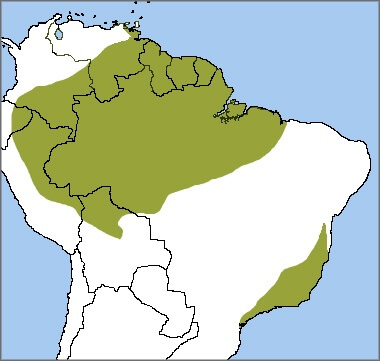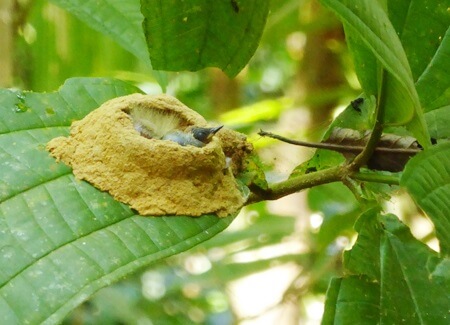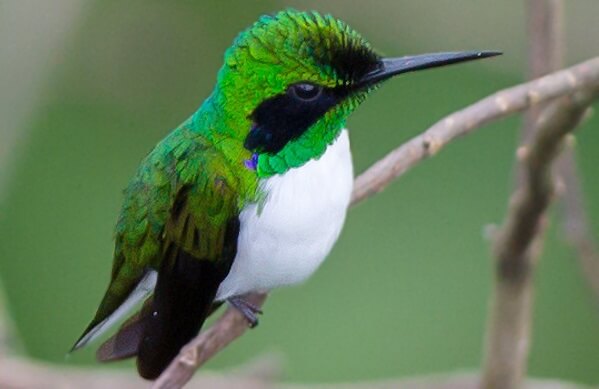 The striking Black-eared Fairy occupies a large range across the tropical forests of South America. It's one of the hummingbirds that caught the eye of 19th century American artist Martin Johnson Heade, whose paintings of this and other species can now be seen in museums such as the Metropolitan Museum of Art.
The striking Black-eared Fairy occupies a large range across the tropical forests of South America. It's one of the hummingbirds that caught the eye of 19th century American artist Martin Johnson Heade, whose paintings of this and other species can now be seen in museums such as the Metropolitan Museum of Art.
It's easy to see how the Black-eared Fairy would attract an artist's attention. This quick, bright green sprite has a contrasting snowy-white underside and black ear patches (auriculars), which give the bird its common name. The sexes are similar, but the female has a longer tail.
The species' total population is unknown but probably decreasing. Loss of tropical forests is the chief threat to the Black-eared Fairy as well as many other South American hummingbirds, from Peru's Marvelous Spatuletail to Brazil's Long-tailed Woodnymph.
Rainforest Regular
Three subspecies of Black-eared Fairy are currently known. Tail length varies depending on the subspecies, but all are proportionally long compared to the bird's approximately 5-inch body.
Most of the Black-eared Fairy population is found in the forests of Amazonia, but one disjunct population is located in the Atlantic Forest of eastern Brazil. There, the fairy makes its home with other striking species such as Swallow-tailed Hummingbird, Seven-colored Tanager, and Pin-tailed Manakin.
Sign up for ABC's eNews to learn how you can help protect birds
Flower-boring Hummer
Compared to most hummingbirds, the Black-eared Fairy has a shorter, straighter bill that can present challenges when it comes to accessing nectar – its main food – from larger flowers. The birds get around this limitation by poking small holes in the flower's base and sipping directly from the nectar's source. To add protein to their diets, they hawk small insects from the air and glean them from foliage.
Black-eared Fairies may also visit hummingbird feeders for sugar water, or drink out of bird baths or water fountains.
Leaving Like a Leaf
Like other hummingbirds, such as Anna's Hummingbird and Violet-crowned Hummingbird, the Black-eared Fairy is solitary in all aspects of life other than breeding. The male's only involvement in the reproductive process is mating with the female. One male may mate with several females, and females probably also mate with several males.
The female Black-eared Fairy builds her cup-shaped nest out of plant fibers, typically on a low horizontal branch, and applies green moss to the outside for camouflage. She incubates her clutch for about 15 days, then cares for the young until they fledge.
When leaving the nest, the female exits with a wavering glide and resembles a falling leaf. This behavior is thought to conceal her and the nest from potential predators.

Black-eared Fairy nest with young by Tuija Sonkkila
Garden Fairies
Although the Black-eared Fairy has a large range, the species is considered uncommon because of ongoing destruction of its habitat. One place it may be seen is at Brazil's Serra do Urubu (Forest of Hope) Reserve, where ABC and partner SAVE Brasil are cooperating to protect remnants of the rapidly disappearing Atlantic Forest.
In November 2017, reserve staff inaugurated a new Hummingbird Garden, where visitors may spot the Black-eared Fairy along with about 20 other species, including the Ruby-topaz Hummingbird and Frilled Coquette.
Bennett Hennessey, Brazil Conservation Program Coordinator at ABC, was at the garden's inauguration and reports that the Black-eared Fairy was exceptionally difficult to catch on camera.
"I set up my camera near hummingbird feeders … [and the] Black-eared Fairy was the only one I could not record,” he says. “One bird would perch high in the canopy, quickly visit four feeders, and then be off. It would return an hour or so later, but I could never predict which feeders it would visit or route it would follow.
"The Black-eared Fairy's behavior was very different from the other hummingbirds," Hennessey concludes. “I suspect the Atlantic Forest subspecies forages in the high canopy, covering a vast range of flowers in no particular order."
Donate to support ABC's conservation mission!



















































